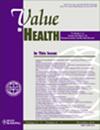Sales Revenues for New Therapeutic Agents Approved by the United States Food and Drug Administration From 1995 to 2014
IF 4.9
2区 医学
Q1 ECONOMICS
引用次数: 0
Abstract
Objectives
This study aimed to analyze worldwide sales of new therapeutic agents and to estimate the time it takes for product sales to exceed industry-wide average drug development costs.
Methods
Data obtained from company reports were analyzed to track worldwide sales of new medicines approved by the US Food and Drug Administration from 1995 to 2014. All sales figures were reported in 2019 US dollars. Kaplan-Meier curves were used to evaluate the time it took for discounted product sales to exceed the average costs associated with developing 1 new drug (accounting for the costs of failed trials), using published estimates of these costs.
Results
Based on data for 361 of 558 new therapeutic agents approved over the study period (median follow-up 13.2 years), mean sales revenue per product was $15.2 billion through the end of 2019; the median was $6.7 billion. These products jointly generated global sales of $5.5 trillion since approval. Revenues were highly skewed, with the 25 best selling products (7%, 25 of 361) accounting for 38% of this amount ($2.1 trillion of $5.5 trillion). Approximately 47% of products had discounted sales that exceeded the estimated industry-wide average costs of development within 5 years of approval, and 75% within 10 years. After attributing potential production, marketing, and other costs, these numbers dropped to 21% of products within 5 years of approval, and 46% within 10 years.
Conclusions
Sales of new medicines approved from 1995 to 2014 were highly skewed, but many products had net discounted sales that exceeded the industry-wide average costs of development within 10 years of approval. An understanding of how sales revenues accrue in the years after initial approval, alongside data on business costs, can inform discussions about how to incentivize private investment in innovation while ensuring affordable prices for patients and the healthcare system.
1995 年至 2014 年美国食品药品管理局批准的新治疗药物的销售收入:一项回顾性研究。
目的分析全球新治疗药物的销售情况,并估算产品销售额超过整个行业平均药物开发成本所需的时间:分析从公司报告中获取的数据,追踪 1995 年至 2014 年美国食品药品管理局批准的新药在全球的销售情况。所有销售额均以 2019 美元为单位。采用 Kaplan-Meier 曲线,利用已公布的成本估算值,评估折扣后的产品销售额超过开发一种新药的平均成本(考虑试验失败的成本)所需的时间:根据研究期间(中位数跟踪期:13.2 年)批准的 558 种新治疗药物中 361 种药物的数据,截至 2019 年底,每种产品的平均销售收入为 152 亿美元;中位数为 67 亿美元。自批准以来,这些产品共创造了 5.5 万亿美元的全球销售额。收入高度倾斜,25 种最畅销产品(7%,25/361 种)的收入占这一总额的 38%(2.1 万亿美元/5.5 万亿美元)。约 47% 的产品在获得批准后 5 年内的折扣销售额超过了整个行业的估计平均开发成本,75% 的产品在 10 年内的折扣销售额超过了整个行业的估计平均开发成本。在归因于潜在的生产、营销和其他成本后,这些数字在批准后 5 年内下降到 21%,在 10 年内下降到 46%:结论:1995 年至 2014 年期间获批的新药销售额偏差很大,但大多数产品在获批后 10 年内的净折扣销售额超过了整个行业的平均开发成本。了解销售收入在首次批准后的几年内是如何累积的,同时了解商业成本的数据,可以为讨论如何激励私人投资创新,同时确保患者和医疗系统能够负担得起价格提供参考。
本文章由计算机程序翻译,如有差异,请以英文原文为准。
求助全文
约1分钟内获得全文
求助全文
来源期刊

Value in Health
医学-卫生保健
CiteScore
6.90
自引率
6.70%
发文量
3064
审稿时长
3-8 weeks
期刊介绍:
Value in Health contains original research articles for pharmacoeconomics, health economics, and outcomes research (clinical, economic, and patient-reported outcomes/preference-based research), as well as conceptual and health policy articles that provide valuable information for health care decision-makers as well as the research community. As the official journal of ISPOR, Value in Health provides a forum for researchers, as well as health care decision-makers to translate outcomes research into health care decisions.
 求助内容:
求助内容: 应助结果提醒方式:
应助结果提醒方式:


